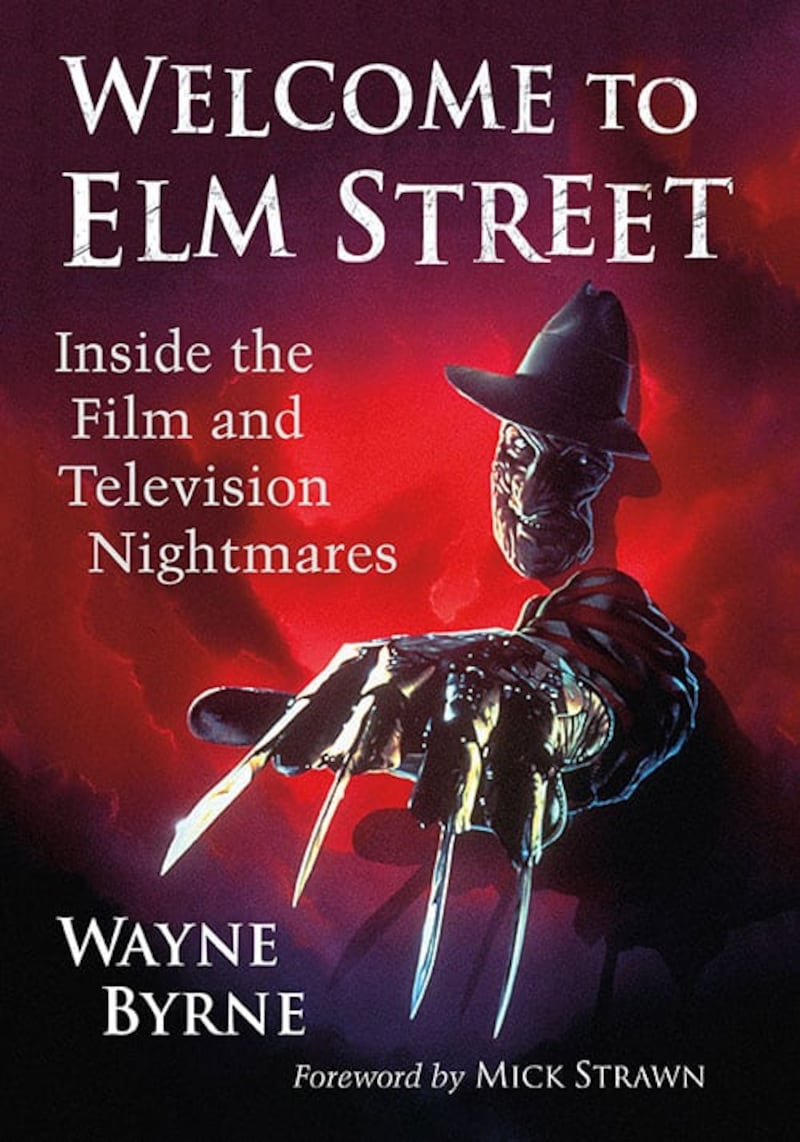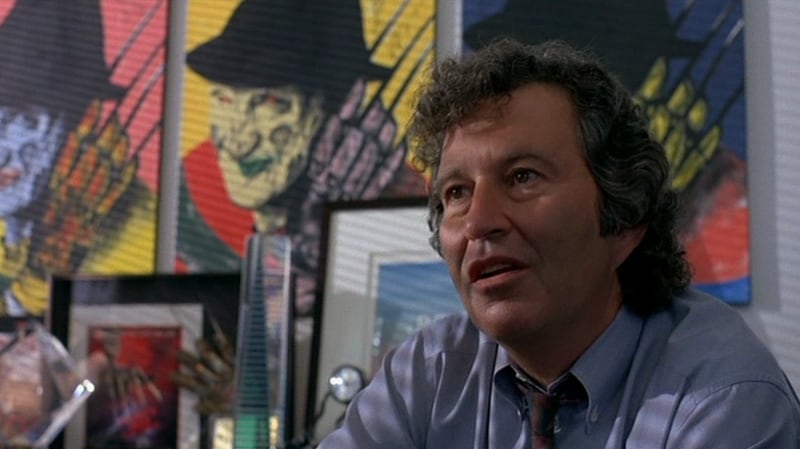In March 2020, my book Nick McLean Behind the Camera: The Life and Works of a Hollywood Cinematographer was published just as the country came grinding to a halt.
There would be no libations at a lavish literary launch, though prior to release we got to celebrate Nick’s career with a speaking tour across Ireland and share some Hollywood war stories over the national airwaves. But after publishing three titles within three years I planned a book break of about three months, fearing burnout and fancying sleep before three in the morning.
But after a week of inactivity I became restless, swiftly discovering that I needed to be writing again; when I’m not, I have little interest elsewhere, my mind is preoccupied and fixated on the next project. I knew immediately what that book would be, so I got working.
Like my previous works, the subject is something meaningful to me: A Nightmare on Elm Street. Among my earliest memories of movies is being beguiled by the indelible image of Freddy Krueger as I perused the video shops of Naas circa 1989. With my father in tow and some lenient shop assistants, I could rent the Elm Street films with impunity and discover my love of movies within those VHS tape reels.


I was further elated when the television series Freddy’s Nightmares began airing on the burgeoning Sky One late on Friday nights at the dawn of the nineties; I had my father record it for me to watch on Saturday mornings. Yes, three decades ago a love affair with Elm Street blossomed and has reached peak passion with the upcoming release of Welcome to Elm Street: Inside the Film and Television Nightmares.
As easy as it was to select my subject, it became my trickiest literary project to date, because it grew exponentially in scope. Thankfully so. My initial brief was to discuss the sociological subtexts of these films and to explore the inherent themes in essay form, not strictly a “making of” book.
I had a small number of writers and directors in mind to talk to and so engaging a vast array of people who made the movies was never part of the plan. I felt their story was already comprehensively covered in previous books and in the four-hour documentary, Never Sleep Again. I didn’t want to regurgitate well-trodden tales well-told elsewhere. What stories were left to tell?
Well, plenty, as it turned out. After speaking to those select few I was soon being connected with others involved in the franchise, constantly finding out more intriguing information and amassing a surplus of material, so I concluded it would be wise to incorporate production and industrial contexts to support the central thematic discourse.
Along with charting the cerebral concerns and artistic intentions of directors, writers, cinematographers, and composers was the parallel narrative of the practical problems facing producers, effects artists, and crew members whose stories are those of strict deadlines, high pressure and low budgets. I’d now be juggling my intended consideration of intellectual themes with that of objectively documenting the production of the myriad films and television texts, and assuming the editorial task of incorporating many more voices than I was used to.
My first three books focused on single subjects: an actor, a director, a cinematographer, so each is driven by a single personality: Burt Reynolds, Tom DiCillo, Nick McLean; this book is driven by 30 personalities. Composing the narrative with those contributors posed its own unique challenge, as opinions were divided, memories were vivid, and feelings were strong; but within those evocations the dramatic arc of the book finally emerged.
Whilst racing against impending release dates to make the best possible films under difficult circumstances and short schedules, all conceivable conflicts that could occur amongst directors, actors, writers, producers, crew, network executives, and studio suits took place. But those challenges were always conquered by fierce filmmaking resolve and insatiable public appetite for the material.
Presiding over all this was New Line Cinema, which had emerged as a scrappy NYC distribution company before its triumphant run as a major Hollywood studio, “The House That Freddy Built”. Founder Bob Shaye was celebrated as a daring, visionary mogul; though he could be torn between the artistic integrity and the commercial interests of his most lucrative property as it reached its pop-cultural peak in the mid-to-late 1980s.
The common thread woven throughout, by cast, crew or corporate, is that everyone involved worked tirelessly, and exhaustively, to entertain audiences with prime product. Some filmmakers could be dogmatic in trying to remain true to Craven’s original concepts, while other filmmakers vied to deliver something different, and in the respective contexts of box office receipts and public opinion, some failed and some succeeded. Either way, they provided audiences with some of the richest horror entertainment to come out of Hollywood in the last 40 years and provided me with the kind of material to make a most riveting book. I hope.
Ten Things I Learned...
1) Robert Englund loves to talk. Everyone from the franchise told me this, and then I found it to be true first-hand. He is witty, gregarious, deeply intelligent, full of old Hollywood stories, and was very receptive of my thematic hypotheses, giving me the kind of sociological and psychological insights that validated my approach.
2) Wes Craven was a genius. I already knew this, so I didn’t really “learn” it. However, the absolute approbation for him within the filmmaking community was a wonderful reassurance. Craven had died by the time I began writing, so there was always going to be an element of tribute to the man who invented Freddy Krueger and made Elm Street a symbol of suburbia.
His friends, collaborators and Hollywood peers declared him to be a rare genius who brought intellect to mainstream genre filmmaking and who created not only one iconic, game-changing pop-cultural touchstone in A Nightmare on Elm Street, but two, including his 90s meta-horror mega-hit, Scream. Both franchises changed the horror genre and contributed considerably to the financial might of their respective studios: New Line Cinema and Miramax.

3) It wasn’t always fun on set. A Nightmare on Elm Street 3: Dream Warriors might be the fan favourite, but production was fraught with tension. Animosity existed between the director and certain actors, while friction brewed amongst the crew as the sensibilities of older unionised veterans clashed with those of the younger non-union crew.
4) Some people are embarrassed about Freddy’s Nightmares. Yes, the television spinoff is considered by many who made it to be a step too absurd. Though while several directors candidly voice their criticisms of the show, others still look upon it with affection for the creative liberty it afforded them.
5) Bob Shaye didn’t want to pay $10,000 for a Sinead O’Connor song to feature in the fourth film. Just as O’Connor’s debut The Lion and the Cobra was taking off, producer Rachel Talalay was keen to include the single I Want Your (Hands on Me) on the pop-heavy soundtrack, but the New Line boss screamed her down, refusing to pay twice as much for an O’Connor song than he had for other acts such as Blondie, Billy Idol, and The Divinyls. After an intense standoff, Shaye demanded that production staff voice their opinion, expecting them to side with him, though they were unanimously in favour of licensing the song. Talalay was vindicated and the song remains a choice needle drop.
6) Robert Englund loves to dine on the wine and fish at The Winding Stair whilst looking out on the banks of the Liffey. Freddy loves Dublin!
7) Several of those who worked on the franchise had never seen an Elm Street film prior to taking the job nor had much interest in the horror genre. But they soon learned that because of their contributions to the franchise, the horror genre would have much interest in them; their association with Elm Street has led to much celebration, acclaim and work.
8) Having loved the formal franchise for three decades, I never questioned what entries were good or bad, I just accepted my absolute adoration for them regardless of inherent quality. That changed when re-examining them intensely and (somewhat) objectively for the book. I discovered that, yes, some films are better than others. And so my order preference: 1) A Nightmare on Elm Street; 2) Part 3: Dream Warriors; 3) Part 4: The Dream Master; 4) Freddy’s Dead: The Final Nightmare; 5) Part 2: Freddy’s Revenge; 6) Part 5: The Dream Child
9) I still hate the 2010 remake.
10) I now know that horror films and the Elm Street franchise provided me with the greatest film education I could have had as a child. I’m glad that while everyone else my age was watching Honey, I Shrunk the Kids! I was illicitly renting A Nightmare on Elm Street for the 20th time. I guess New Line Cinema was my Disney.


















